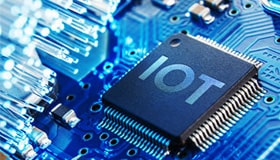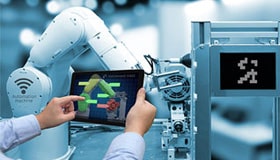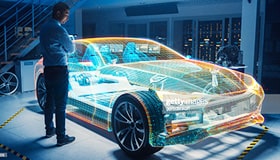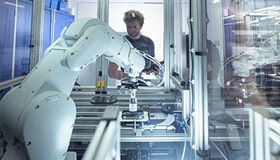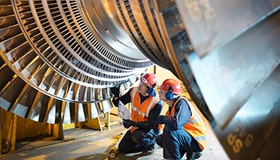Industrial intelligent robotics for agile manufacturing
Ongoing developments in hardware technology, together with the impact of AI in creating more sophisticated software solutions, are enabling manufacturers across all industries to improve productivity while cutting costs and carbon footprints with the use of using industrial robotic systems.
This article looks at the types of industrial robots available, and the key semiconductor, software, and AI technologies used to build them. It also compares the various approaches of some of the major semiconductor manufacturers.
The origins of robotics can be traced back to the early 1800s when scientists began experimenting with automatons, or self-operating machines. In the 1950s, the field of robotics took off, thanks to pioneers like George Devol and Joseph Engelberger. Devol’s invention of programmable universal automation controllers laid the groundwork for modern industrial robots, while Engelberger’s company, Unimation, built the first robot arm used in factories. Today, industrial robots can be found in a wide variety of settings, from car assembly plants to food processing facilities.
As industrial robots continue to become more sophisticated, their use will likely become even more widespread in the years to come. Specifically, the global industrial robot market, which reached USD 43.58b in 2021-22, is expected to grow at a CAGR of 12.52% until 2030, reaching a value of USD 88.45b by then .
An industrial robot is a robot system used for manufacturing. Industrial robots are automated, programmable and capable of movement on three or more axes. They comprise a complex synthesis of interdependent mechanical and electronic design aspects: an excellent mechanical design will not perform adequately without a high level of electronic integration, and vice versa. However, it is also true to say that robotics developments are being driven rapidly by their semiconductor and software elements. Hardware is becoming faster, more energy-efficient, smaller, and lower-cost, while software, boosted by AI technology, is becoming more sophisticated.
These trends are reflected by the level of electronic enhancement in the form of sensing or awareness of heat, sound, position, and other ambient conditions, data processing speed and power, and the level of sophistication or intelligence of algorithms applied by robots to trigger actions and decisions. High-precision movement, for instance, is driven by highly complex motor control algorithms, while the sensing instruments are supported by intelligent agents.
Modern industrial robots can be broadly classified into three types:
- Fixed, or mounted: a robot arm in a factory cell, for example.
- Collaborative robot or cobot: a robot designed to interact directly and safely with their human ‘colleagues’.
- Mobile robot: used for applications like moving goods around a warehouse.
Below, we compare and contrast these different robot types. As we do so, we also take the opportunity to compare different manufacturers’ approaches to robot design; we look at Analog Devices’ fixed robot ecosphere. We consider cobots as a special case of fixed robots, with extra safety requirements because of their proximity to humans. We provide details of ST Microelectronics’ turnkey gesture recognition solution as a practical example of cobot-related technology.
Next, we look at Infineon’s solutions for mobile robots, together with a practical implementation from Renesas.
Fixed or mounted robots
Fixed robots are bolted to the factory floor or another surface. Generally, they are robotic arms designed for tasks like picking and placing, sorting, assembling, welding, and finishing. Articulated robot arms offer the most flexible movement of all robot arm types. They can be powerful and capable of lifting heavy objects. However, this means they may need to be fenced off.
Of all robot arm types, their movement most closely resembles that of a human arm. It typically has six axes, or joints, giving it six degrees of freedom. The more joints a robot has, the more smooth and less 'robot-like' its motion becomes.
A robot arm is typically fitted with a gripper, such as a suction cup or electromagnet. More sophisticated finger grippers are available to pick up delicate objects such as eggs or fresh produce. Alternatively, the arm could be equipped with a tool such as a rotating tool that holds a drill bit, or a deburring, grinding, or milling tool. Specialist tools for welding, painting, sanding, laser cutting, and many other functions are also possible.
Articulated robots are used in applications such as pick and place, arc welding, spot welding, packaging, machine tending, and material handling. The ability to produce arcs (or similar patterns) in hard-to-reach places makes articulated robots a good candidate for the automotive industry and other manufacturing industries, which require this ability.
Cartesian robots are simpler, cheaper three-axis types that can only perform linear movements in a Cartesian system. They are very accurate and repeatable, and can lift heavy objects. They can be used for pick-and-place, material handling, packaging automation, storage and retrieval, cutting and drilling, and many more applications.
SCARA (Selective Compliance Assembly Robot Arm) robots are interesting variants. They can rotate in two joints and have one linear joint. They are 'compliant' in the horizontal plane and rigid (not compliant) in the vertical. Selective compliance is useful in assembly operations in which a part needs to be inserted into a circuit board, for example. This kind of assembly often requires a part to be fitted into a hole. The widespread use of SCARA robots revolutionized the small electronics industry. Due to their small footprint, simplicity, and design characteristics, they are uniquely well-suited for this application arena and have proven to be highly cost-effective.
Other fixed robot types include polar or spherical, delta or parallel, gantry, and cylindrical. Cobots are also typically implemented as fixed robots. Additionally, many CNC machines can be considered as fixed robots.
Fixed robot technology and components
Analog Devices (ADI) offers full systems encompassing multiple technologies for subsystem elements, from motor drive and servo systems to sensing and connectivity. Their mounted robotics portfolio is backed by decades of innovation and domain expertise that enable more intelligent and flexible robots and cobots, step-changing productivity and efficiency, and modular designs from sensors to cloud.

Figure 1: Analog Devices’ view of a fixed robot, showing key features
The five key elements shown in Fig.X are described below:
1. End effectors and toolsSmart grippers and end effectors extend the range of tasks robots can perform. With flexibility and productivity being key objectives, ease of use and quick tool changes are possible with plug and play connector interfaces. In addition, precise force and torque sensing and measurement allow for gains in productivity, such as appropriate component handling, optimal surface finishing, lead screw tightening, and many other applications.
Gripper reference design: The TMCM-1617-GRIP-REF is an open-source hardware reference design for the TMCM-1617 BLDC servo driver. To be used in robotic gripper applications, the board is designed in a standard gripper electronics form factor. It can control a BLDC motor via EtherCAT®, IO-Link®, or RS485 using Trinamic's TMCL protocol. In addition, the board features one configurable analogue output and one configurable analogue input, using Analog Devices MAX22000 industrial configurable analogue IO device and four configurable digital inputs, and digital outputs, using Analog Devices MAX14906 device.

Figure 2: Analog Devices’ TMCM-1617-GRIP-REF open-source hardware reference design for the TMCM-1617 BLDC servo driver, to be used in robotic gripper applications
2. Robot ecosystemTo enable more complete systems and end solutions, ADI offers a wide range of modules and systems, created and architected with customer end applications in mind. With the aid of strong partner collaboration, ADI is enabling our technologies beyond silicon by embracing system services, applications software, firmware and much more.
Inertial measurement units (IMU)Analog devices’ inertial measurement unit (IMU) sensors are based on multiaxis combinations of precision gyroscopes, accelerometers, magnetometers, and pressure sensors. Their technology reliably senses and processes multiple degrees of freedom, even in highly complex applications and under dynamic conditions. These plug and play solutions include full factory calibration, embedded compensation and sensor processing, and a simple programmable interface.
The ADIS16470/ADIS16475/ADIS16477 and ADIS16460/ADIS16465/ADIS16467 industrial inertial measurement units offer a no compromise solution to system developers previously inhibited by the performance limitations of commercial-grade sensors. Analog Devices’ advancements in MEMS inertial sensing enable exceptional stability at breakthrough price levels. Whether for precision instrument stabilisation or guidance and control, these new sensors deliver a wide dynamic range, ultralow noise, and angular and linear acceleration sensing with stable operation, even under severe environmental disturbances.

Figure 3: Analog Devices industrial inertial measurement units
3. Teach pendant and HMITeach pendants are designed to control the robot through a teach-and-repeat technique, where the operator uses the teach pendant to program the robot for a specific task, range of motion, or speed. The operator uses the controls on the robot pendant to provide the robot with information about speed, delay times, and execution of specific functions as well as to define the robot’s physical relationship with the other machinery that may be involved in the process.
Multi-axis synchronization is critical in robotic applications. ADI’s Chronous™ portfolio of Industrial Ethernet solutions, including platforms, switches, and physical layer devices, supports all major Industrial Ethernet protocols and provides multi-protocol flexibility, ease of use, and support. These future-proof products are for today’s Industrial Ethernet networks and tomorrow’s converged networks-based Time-Sensitive Networking (TSN).
Analog devices offer the only wireless networks designed for the harshest industrial environments where low-power, reliability, resilience, and scalability are key. A 5G wireless network will bring better reliability, reduced lag time, and increased efficiencies to the factory floor. Additionally, audio/voice interface can be used for more dynamic robot control.
In industrial applications, no single wireless technology is king. Low bandwidth and low-power technologies are best for meter deployments with occasional connectivity needs. In contrast, for autonomous guided vehicles (AGV) deployed in busy factory floors with multiple sensors communicating simultaneously and continuously, higher bandwidth options are needed.
Analog devices’ range of wireless communications technology enables connectivity to sensors in remote and hard-to-access hazardous locations without the need to deploy a wired network. ADI offers highly advanced wireless subsystems and complete signal chain solutions focused on reducing the design burden and speeding up deployment. These solutions include SmartMesh®, 5G, Bluetooth® low energy (BLE), and 60 GHz latency-free wireless data interconnects.
4. Axis and joint motion controlThe demand for higher robotic and machine throughput requires faster servo drive response time and more precise axis synchronization. Controlling the motors and the motion in each joint in a multi-axis system relies on critical real-time measures of flux, current and voltages in the motors. ADI has a long history of servo drive domain experience offering high-performance closed loop servo drive solutions and platforms. Their industry-leading data conversion, power conversion and iCoupler® magnetic isolation technology enable high-performance motor control and robustness in the harshest electrical environments.
Trinamic’s motion control expertise and Analog Devices' analogue process technology and power design skills will enable a new class of intelligent actuators. This extends designers’ ability to deliver intelligence at the edge.
For robots and AGVs, intelligent actuators at the edge can free the central master from detailed motion control commands. By gathering and processing real-time information themselves, Trinamic's motor and motion control products only need simple commands from a master to figure out the most efficient way of performing the task at hand. From now on, masters only need to make top-layer decisions, freeing them up to focus on other aspects instead.
This approach helps to optimizeperformance and reduce energy wastage. On-the-fly changes using popular protocols and interfaces can achieve higher throughput.
Safety can also be increased by using sensor-free technologies for advanced protection and diagnostics features.

Figure 4: Analog Devices TMCM-3351 three-Axis Stepper Servo Module • 11..28V • RS232, RS485, CAN, USB • Closed-Loop Control • S-Shaped Ramping • Multi-Purpose IOs
5. Controller, iInterfaces and powerThe main controller is the brain and facilitator of the robot. It enables real-time motion (if the joint is not directly driving this control function) and enables both power and connectivity. Real-time connectivity allows data to stream seamlessly from sensors and end effectors to the main control unit, optimizing more advanced control and human engagement.
μModule design and manufacturing resources: A µModule® power product simplifies the implementation, verification, and manufacturing of complex power circuits by integrating the power function in a compact molded plastic package. Guides are available for product selection, design, evaluation, simulation, layout, PCB assembly, and packaging.

Figure 5: µModule® plastic power package
Collaborative robots (cobots)
Cobots are generally a type of fixed robot, so they can benefit from fixed robot component technologies as described above. However, their role in working alongside or even in contact with humans adds an extra dimension to their safety design and legislation considerations.
Cobots work outside the limitation of a safety cell and share workspace with humans. This setup requires a precise set of features. Cobots are designed for safe collaboration with humans while maintaining high productivity. Infineon, for example, provides semiconductor solutions for smart connectivity and reliability, advanced sensing technologies, quick reaction time, and embedded modular safety functions.
ISO/TS 15066 is a new ISO technical specification that defines how humans and robot systems can safely interact in industrial settings. It covers important characteristics of safety control systems, factors to be considered in the design of collaborative robot systems, and guidance on implementing the following collaborative techniques: safety-rated monitored stop; hand guiding; speed and separation monitoring; power and force limiting.
Collaborative power- and force-limited robot applications can be developed using information about pain thresholds of different human body parts. Another way to facilitate human and robot system collaboration is through speed and separation monitoring techniques. In such systems, a minimum safety distance between the robot system and the person is maintained to avoid contact.
The technical specification offers detailed guidance on maximum allowed speeds and minimum separation distances. It can inspire further advancements in protective device technology as well as the development of materials to soften physical contact, better sensors, improved motion control and other innovations.
The working group also requires that sharp edges and protrusions be minimized for the entire system and associated equipment so that if a human were to impact machinery, they would be no worse off than if they walked into a wall.

Figure 6: Cobots can be designed for safe proximity and even contact with humans
Gesture recognition: Gesture recognition can contribute to smooth interaction between cobots and humans as part of a multi-modal human-robot interaction system that could also include pose estimation, physical interaction, and sonic notification .
ST Microelectronics offers a turnkey gesture recognition solution based on their VL53L5CX multizone Time-of-Flight ranging sensor. This solution is designed to provide low-cost gesture recognition functionality using a Time-of-Flight (ToF) ranging sensor and an STM32 microcontroller. It represents a highly robust and reliable alternative to camera imaging techniques, as ToF sensors do not present privacy issues or performance loss due to poor lighting or unreflective surfaces.
The sensor employed in this design is the VL53L5CX Time-of-Flight ranging sensor featuring a wide field of view and 8x8 multizone detection. The software provided for gesture recognition functionality runs on an STM32F401 MCU, which balances power consumption and processing performance and offers a substantial set of interfaces and integrated peripherals.

Figure 7: Components of ST Microelectronics turnkey gesture recognition solution
Mobile robots
Warehouse operators are under more pressure than ever to keep up with picking, packing, moving stock around the warehouse, shipping and other critical logistical activities. And, with ecommerce and direct delivery trends set to continue rising, finding ways to boost order fulfilment productivity is becoming a priority.
Mobile robots that work collaboratively with warehouse operatives can contribute significantly to improving productivity in these scenarios. They are also finding roles within hospitals, restaurants, schools, and in last-mile delivery vehicles of packages and goods.
Many types of mobile robots exist, but Fig.8 and the description below show the two fundamental types.
AGV - Automated Guided Vehicle: AGVs are fixed. They follow predefined paths using lasers, sensors, barcodes, or magnetic tape for navigation.
AMR - Autonomous Mobile Robot: AMRs are not fixed and don’t need external paths. They use sensors for autonomous mapping, navigating, and obstacle avoidance.

Figure 8: The two fundamental types of mobile robot
Renesas offers a solution that demonstrates the advantages of AMR over AGV: Their NextAMR is an AI-equipped autonomous mobile robot, focusing on the low and mid payload segment. Unlike conventional AGVs, NextAMR can operate without dedicated rails, automatically searching for the optimal route, maneuvering skilfully in environments with people and other obstacles. The solution can control the autonomous running of each robot, and manage the collaboration of multiple robots at the same time. low-power efficiency and real-time processing are made possible by using RZ/V series embedded AI MPUs.

Figure 9: Renesas NextAMR autonomous mobile robot environment
However, all types of mobile robots require unique and appropriate solutions, comprising the following elements:
- Space and energy saving motor control (motor inverter switches, integrated motor control solutions)
- Efficient power supplies / SMPS for fast charging and wireless charging
- Battery management systems (BMS)
- Sensing (robot sensing, environment sensing, HMI)
- Connectivity (WiFi, BT, Industrial interfaces, and transceiver)
- Security and safety (embedded security solutions, safety controller and sensor systems)
Motor control: The accelerating trend of electrification of the powertrain is driving tremendous growth in design and use of electric motors. Various types of motors such as Brushless DC Electric Motors (BLDC), internal Permanent Magnet Synchronous Reluctance Motors (PMSM) and AC Induction Motors (ACIM) are used in applications that require high-power and are driven by a battery (V Bus
These motors are driven by high-power-low voltage motor drives. The design of high-power motor drives tends to be characterised by a high degree of paralleling of motor drive MOSFETs and, in some cases, may require isolation.
Fig.10 below summarises Infineon’s families of products available for building high-power BLDC/PMSM/ACIM motor drives.

Figure 10: Infineon product families for building high-power BLDC/PMSM/ACIM motor drives
Power supplies: Infineon Technology provides a full spectrum of power controllers and switches, including ac-dc controllers, dc-dc converters, silicon and SiC MOSFETs, GaN HEMTs, Intelligent Power Modules (IPMs), lighting ICs, transistors (IGBTs), diodes and rectifier, regulators, isolation interfaces, voltage and current management for internal and external power supply applications.
Their design solutions increase active-mode efficiency, decrease standby-mode power consumption, and provide power factor correction at every stage of your layout from line to load.
Infineon offers a variety of IPMs, with various semiconductors in different packages and a range of voltage and current classes. These IPMs are separated into Compact, Standard and Performance families. These energy-efficient intelligent power module IGBTs integrate the latest power semiconductor and IC technology.
The intelligent power modules use Infineon’s advanced IGBTs, MOSFETs, next-generation Gate Driver ICs, and state-of-the-art thermo-mechanical technology. The modules improve system performance and energy efficiency by delivering increased power density, enhanced system ruggedness and reliability.
Battery management system (BMS): When designing a BMS, the designer often starts with the cell monitoring and balancing (CMB) device. The CMB device is also known as the BMS IC or Analog
Front End (AFE). Often located on a Cell Management Controller (CMC) unit, the CMB’s function is to measure the voltages and temperatures for cells and communicate this information to the main controller. Additionally, the CMB can undertake diagnostics of cells and their surroundings (for example, detecting connection failures in the circuit surrounding a cell, such as open or short circuits).
The CMB device is also responsible for balancing the cells. Cell imbalance comes from the fact that high voltage batteries are built out of many single cells in series, which inevitably have production variances, for example in cell characteristics or the heterogeneous thermal spreads in the final pack.
Additionally, to achieve extreme low-power, dedicated housekeeping functions such as periodically scheduled cell measurements and state analysis required for functional safety can be performed by the CMB independently from the master controller of the BMS. Safety features for signalling over-/under-voltage, thermal stress, etc., including emergency alarms, are triggered autonomously.
The Infineon TLE9012DQU is a multi-channel battery monitoring and balancing IC designed for Li-Ion battery packs used in many automotive, industrial, and consumer applications. TLE9012DQU fulfils four main functions: cell voltage measurement, temperature measurement, cell balancing and isolated communication to the main battery controller. Additionally, TLE9012DQU provides the necessary diagnostic tools to ensure proper function, guaranteeing the safety of those around the controlled battery.

Figure 11: TLE9012DQULi-Ion battery monitoring and balancing IC
Sensing: Infineon’s XENSIV™ family was developed to meet today’s sensing challenges in automotive, industrial and consumer applications. Spanning magnetic sensors, current sensors, pressure sensors, acoustic sensors, 3D image sensors (REAL3™) and radar sensor MMICs (RASIC™ for automotive), XENSIV™ meets all performance and integrity needs, regardless of the industry.
Infineon’s REAL3™ time-of-flight image sensors enable electronic devices to acquire a real 3D map of the scene in front of the device. The surroundings, objects and people are transformed into the digital space in real-time. Algorithms use that data to measure distances and sizes, track motions and convert the shape of objects into 3D models. Our products are designed to be integrated into the smallest 3D ToF camera modules, accurately measuring depth in the short and longer ranges at the lowest power consumption.

Figure 12: Infineon’s REAL3™ time-of-flight system
Connectivity: AIROC™ wireless connectivity products, including Wi-Fi®, Bluetooth®, Bluetooth® Low Energy, and Wi-Fi and Bluetooth® combos, have shipped more than a billion devices and are the go-to choice for IoT and automotive solutions.
AIROC™ products leverage a common software framework across Android, Linux, and RTOS platforms and are pre-integrated with Infineon’s ModusToolbox™ software and tools, allowing developers to deliver high-quality, differentiated products to market on time and budget.
Infineon’s AIROC™ Wi-Fi & combos portfolio integrates IEEE 802.11a/b/g/n/ac/ax Wi-Fi and Bluetooth® 5.2 in a single-chip solution to enable small-form-factor IoT designs. Combo, standalone Wi-Fi, and Wi-Fi SoCs with embedded MCU and on-chip networking capabilities are also offered in 1x1 SISO and 2x2 MIMO configurations. Wi-Fi and combo solutions can be coupled with external MCUs from Infineon and others for RTOS, along with Linux on application processors to implement a complete Wi-Fi + Bluetooth®/Bluetooth® Low Energy system.
AIROC™ Wi-Fi SoCs include on-chip MCUs, memory, and the networking protocols required for customers to easily create their own cloud-connected applications.
Infineon’s modustoolbox™ software and tools provide code examples and development support for Wi-Fi SoCs or adding Infineon’s secure and low-power PSoC™ MCUs and sensors to IoT applications. Infineon also supports our customers through our global network of IoT partners using production-ready, fully-certified AIROC™ Wi-Fi & combo modules based on both Linux and RTOS based platforms.

Figure 13: The CYW943907AEVAL1F Evaluation Kit enables you to evaluate and develop single – chip AIROCTM Wi-Fi applications using CYW43907 devices
Security: Security is of critical importance within an isolated production plant and even more so in an interconnected industrial value chain. Infineon’s high-quality industrial security solutions, which are easy to integrate into your designs, enable manufacturers to monitor whether or not only authorized people and machines are communicating. They also reliably reveal if a production system has been manipulated, helping avoid unnecessary downtime. In addition, they enable secured software updates to devices in the field.
The Infineon OPTIGA™ Trust product family offers a full range of security chips to address individual needs in the field of embedded authentication and brand protection and further security applications. Whether you are looking for a turnkey security chip enabling fast and easy integration or a feature-rich programmable solution, OPTIGA™ Trust has the perfect match for your business model.

Figure 14: Infineon Optiga™ Trust M Security chips
Conclusion
This article has shown how multiple semiconductor manufacturers are offering comprehensive and nuanced ranges of components designed to enable innovative solutions for the various aspects of robot systems.
Newark stocks components from each of these manufacturers, along with expertise in all their offerings. This knowledge and stock availability are invaluable to robotics manufacturers designing their next-generation products; Newark can provide a balanced view of the approaches from all the semiconductor manufacturers, rather than a biased opinion from a single manufacturer.

